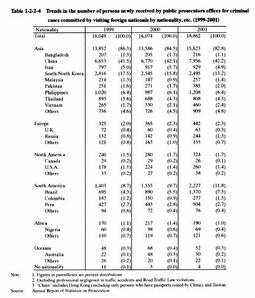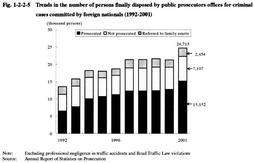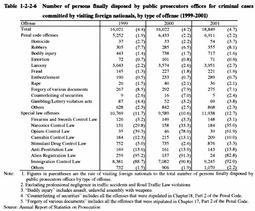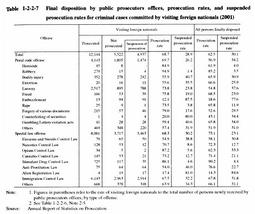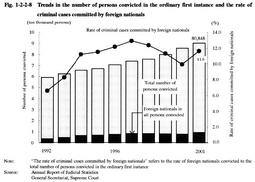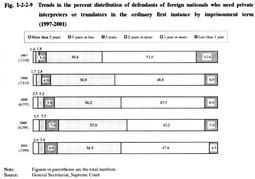| Previous Next Index Image Index Year Selection | |
|
|
3 Treatment of offenders who are visiting foreign nationals (1) Disposition by public prosecutors offices Table 1-2-2-4 shows the number of persons newly received by public prosecutors offices by nationality, etc. for criminal cases committed by visiting foreign nationals in the last 3 years. Persons from China have accounted for the largest share for 3 consecutive years, and those from the Asian region have accounted for more than 80% of the total number of persons newly received by public prosecutors offices.
Fig. 1-2-2-5 shows the trends in the number of persons finally disposed by public prosecutors offices for criminal cases committed by foreign nationals (excluding professional negligence in traffic accidents and Road Traffic Law violations; hereinafter the same this section) in the last 10 years (see Appendix 1-10 ). The number of suspects prosecuted has been rising remarkably, and increased by 2,390 from the previous year to 15,152 in 2001. Table 1-2-2-6 shows the number of persons finally disposed by public prosecutors offices, by type of offense, for criminal cases committed by visiting foreign nationals in the last 3 years. In 2001, the number of visiting foreign nationals finally disposed for criminal cases was 18,849, which accounted for 4.7% of the total persons finally disposed by public prosecutors offices, and 76.3% of the total foreign nationals finally disposed. By type of offense, as for penal code offenses, larceny had the largest percentage share (57.2%), followed by bodily injury (10.4%), robbery (5.1%), and embezzlement (4.2%). As for special law offenses, Immigration Control Law violations had the largest percentage share (77.4%), followed by Stimulant Drug Control Law violations (7.3%), Cannabis Control Law violations (1.8%), Narcotics Control Law violations (1.5%), and the total of all the above drug-related offenses and Opium Control Law violations accounted for about 10% of the total number of special law offenses. Table 1-2-2-7 shows the final disposition by public prosecutors offices for criminal cases committed by visiting foreign nationals in 2001, by contrast with the disposition of all criminal cases. Comparing prosecution rates of visiting foreign nationals with those of the total persons finally disposed, as for visiting foreign nationals, the forgery of various documents, homicide, larceny, and robbery, etc. are high among penal code offenses, and Opium Control Law violations are high among special law offenses. Moreover, offenses where prosecution rates of visiting foreign nationals are low, include counterfeiting of securities, etc. among penal code offenses, and Anti-Prostitution Law violations, etc. among special law offenses. Table 1-2-2-4 Trends in the number of persons newly received by public prosecutors offices for criminal cases committed by visiting foreign nationals by nationality, etc. (1999-2001) Fig. 1-2-2-5 Trends in the number of persons finally disposed by public prosecutors offices for criminal cases committed by foreign nationals (1992-2001) Table 1-2-2-6 Number of persons finally disposed by public prosecutors offices for criminal cases committed by visiting foreign nationals, by type of offense (1999-2001) Table 1-2-2-7 Final disposition by public prosecutors offices, prosecution rates, and suspended prosecution rates for criminal cases committed by visiting foreign nationals (2001) (2) Disposition by courts Fig. 1-2-2-8 shows the trends in the rate of criminal cases committed by foreign nationals to the total cases in which offenders were convicted in the ordinary first instance (the rate of foreign nationals who were convicted to the total persons convicted; hereinafter the same in this subsection). The number of foreign nationals who were convicted has continued to increase since 1992, peaking at 8,473 in 1997. Since then, it has been on a decreasing trend and fell to 7,740 in 2000. However, the number took an upward turn in 2001, reaching 9,396.
The rate of criminal cases committed by foreign nationals has been on a decreasing trend since 1998 after peaking in 1997, of which trends are the same as those of the number of foreign nationals convicted. While the rate in 2000 decreased by 3.0 points to 9.9% compared to the peak of 12.9% in 1997 due to growth in the total number of persons convicted, it numbered 11.6% in 2001, increasing by 1.7 points from the previous year. By language, concerning defendants of foreign nationals who need private interpreters or translators, the percent distribution of persons finally disposed in the ordinary first instance (a total of 6,328) in 2000, shows 38.8% in Chinese, 15.6% in Korean, 6.8% in Tagalog, 6.4% in Persian, 6.2% in Thai, 5.3% in Portuguese, and 4.7% in Spanish, and the total number of languages interpreted was 36 (Source: General Secretariat, Supreme Court). Fig. 1-2-2-9 shows the trends in the percent distribution of defendants of foreign nationals who need private interpreters or translators in the ordinary first instance by imprisonment term in the last 5 years. Persons sentenced to imprisonment for 1 year or more (and less than 2 years) dropped to less than 50% in 1998 and then decreased to 42.2% in 2000. However, the figure took an upward turn and increased to 47.8% in 2001. Fig. 1-2-2-8 Trends in the number of persons convicted in the ordinary first instance and the rate of criminal cases committed by foreign nationals Fig. 1-2-2-9 Trends in the percent distribution of defendants of foreign nationals who need private interpreters or translators in the ordinary first instance by imprisonment term (1997-2001) |
